How to Check the Grounding or Earthing System at Home using a Light Bulb?
In today’s tutorial, we will demonstrate how to test and check the earthing or grounding system at home using a light bulb. This will help determine whether the ground connection is effective, faulty, or nonexistent. Please note that while this method is commonly used, it may not be as accurate and effective as specialized equipment designed for precise ground resistance measurements, such as a ground resistance tester or a clamp-on ground resistance meter. These instruments are specifically designed to deliver reliable and accurate measurements in diverse grounding scenarios.
- Please note that working with electricity can be dangerous, and if you are not familiar with electrical systems, it’s advisable to seek help from a qualified electrician.
- Also, ensure that all safety precautions are taken before attempting any testing.
- The author will not be liable for any losses, injuries, or damages resulting from the display or use of this information or any attempt to implement a circuit in the incorrect format. Therefore, exercise caution, as working with electricity poses inherent risks.
Related Posts:
- How to Test Grounding / Earthing System using a Multimeter?
- How to Measure Earth Loop Resistance Using Ammeter and Voltmeter?
Materials Required:
- A 60W Light Bulb
- A Plugin Lamp Holder – Light Bulb Holder / Bulb socket base with insulated extension wire testing leads.
- 120V or 240V / 230V Outlet / Receptacle / Socket
Connect the Probes of Light Bulb to the Outlet/Socket:
- Test 1:
- Connect the Black lead from the light bulb holder to the Neutral slot. In 120V outlet, the wider port is Neutral.
- Connect the Red lead from the light socket base to the Phase / Live slot. In 120V ordinary outlet, the narrow port is (Hot or Line).
- Observe: If the socket/outlet is connected to the power supply, the light bulb will turn ON and glow.
- Test 2:
- Connect the Black lead from the light bulb holder to the Ground/Earth slot. In 120V outlet, the green terminal is Ground.
- Connect the Red lead from the light base to the Phase (Line, Live or Hot) slot.
- Observe: If bulb ON and the light intensity is same as above in test 1, there is proper earthing – grounding system.
- If the glowing light is dimmer than in the first test, it indicates the presence of an earthing/grounding system, but it is faulty.
Click image or open in new tab to enlarge
Compare the Results:
- Good Grounding System:
If the light intensity of the glowing bulb is the same in both tests e.g., when connected to (1) Phase and Neutral, and (2) Phase and Ground/Earth slot, the grounding system is functioning well.
- Faulty Grounding System:
If the light intensity of the glowing bulb in the first test is brighter than in the second test (e.g., the bulb glows brighter when connected to (1) Phase and Neutral and dims when connected to (2) Phase and Ground/Earth slot).
- No Grounding System:
If the light bulb doesn’t glow in the second test (when connected to the Phase and Ground/Earth slot), but glows brighter when connected to the Phase and Neutral, there is no effective grounding system.
- No Power Available:
When the bulb doesn’t glow in both tests i.e., when connected to (1) Phase and Neutral and (2) Phase and Ground/Earth slot in the outlet/socket, there is either no power supply, the outlet is disconnected from the power supply, or the breaker associated with the outlet circuit is switched off.
Related Posts:
- How to Measure Ground Resistance? – Testing Earth Resistance
- How to Test the Earth Fault Loop Impedance – Various Methods
Here is the comparison chart of each bulb test and its results based on the observation.
| Grounding / Earthing Status | Test Conditions | Interpretation |
| Good Grounding System | Light intensity is the same in both tests (connected to (1) Phase and Neutral, and (2) Phase and Ground/Earth slot). | Indicates a properly functioning grounding system. |
| Faulty Grounding System | Light intensity is brighter in the first test (connected to (1) Phase and Neutral) than in the second test (connected to (2) Phase and Ground/Earth slot). | Suggests a fault in the grounding system, as the bulb glows brighter in the Phase and Neutral connection. |
| No Effective Grounding System | Bulb doesn’t glow in the second test (connected to Phase and Ground/Earth slot) but glows brighter in the Phase and Neutral connection. | Indicates the absence of an effective grounding system. There may be potential safety concerns. |
| No Power Available | Bulb doesn’t glow in both tests (connected to (1) Phase and Neutral and (2) Phase and Ground/Earth slot). | Implies a lack of power supply. The outlet may be disconnected, or the circuit breaker associated with the outlet is switched off. |
Related Posts:
- How to Measure Resistivity of Earth Using Wenner Method?
- How to Test and Measure the Ground Resistance using a Megger?
- How to Size the Earth Conductor, Earthing Lead & Earth Electrodes?
- Protective Multiple Earthing (PME) – TN-C-S – (MEN) and PNB
- Design of Grounding / Earthing System in a Substation Grid
- Why are Salt and Charcoal Added in Earthing Pit for Grounding?
- What is the Purpose of Ground Wire in Overhead Transmission Lines?
- Difference Between Grounding, Earthing and Bonding
- What is the Difference Between Neutral, Ground and Earth?
- Difference Between Real Ground and Virtual Ground
- Why is the Grounding Wire Bare and Not Insulated?
- What is Ground Rod and How to Install a Ground Electrode in Grounding System?
- Why is Copper Rod Used as Ground Rod in Grounding / Earthing System?
- Electrical Earthing and Grounding – Methods, Types and Installation
- What is Ground Resistance Tester – Working of Ground or Earth Tester

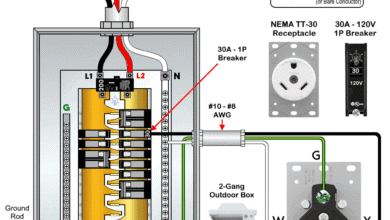 How to Wire NEMA TT-30 Receptacle for RVs & Travel Trailers
How to Wire NEMA TT-30 Receptacle for RVs & Travel Trailers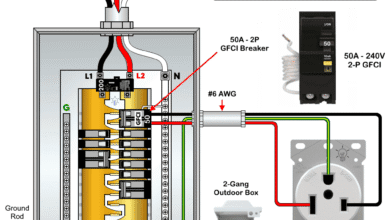 How to Wire a 50A – 250V, NEMA 6-50 Receptacle
How to Wire a 50A – 250V, NEMA 6-50 Receptacle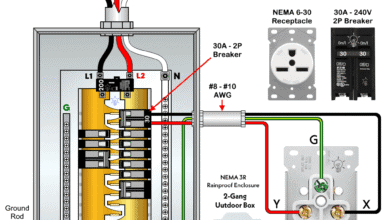 How to Wire a 30A – 250V, NEMA 6-30 Receptacle
How to Wire a 30A – 250V, NEMA 6-30 Receptacle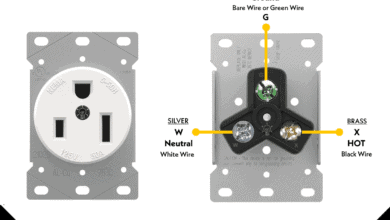 How to Wire a 50A – 125V – NEMA 5-50 Receptacle
How to Wire a 50A – 125V – NEMA 5-50 Receptacle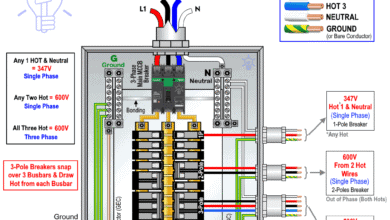 How to Wire 600/347V, 1-Phase & 3-Phase Main Service Panel
How to Wire 600/347V, 1-Phase & 3-Phase Main Service Panel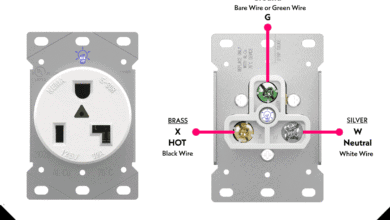 How to Wire a 30A – 125V – NEMA 5-30 Receptacle
How to Wire a 30A – 125V – NEMA 5-30 Receptacle